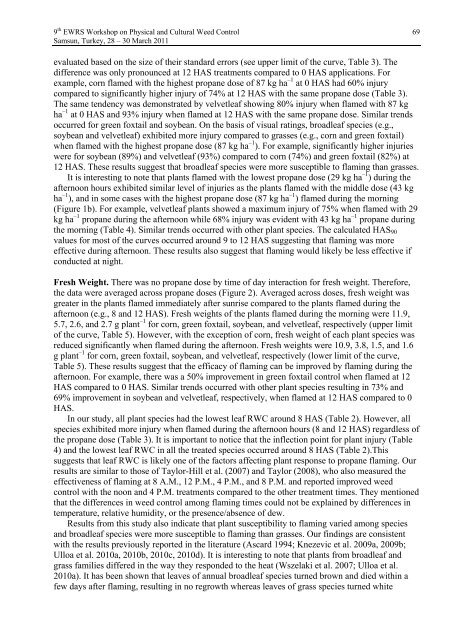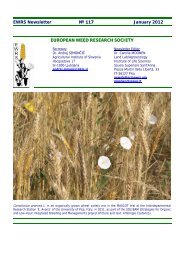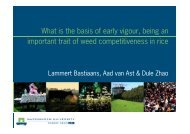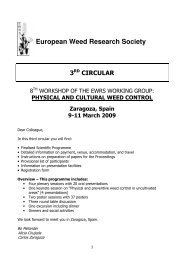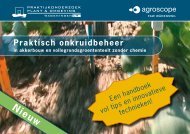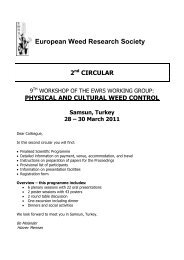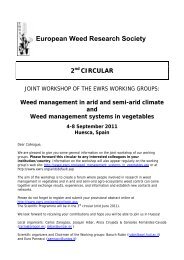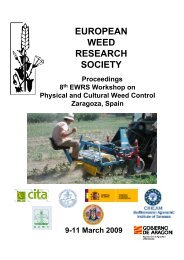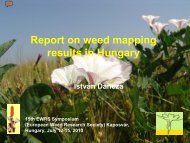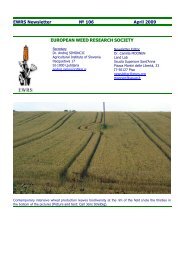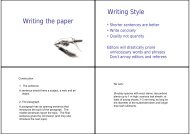Physical and Cultural Weed Control Working Group of - European ...
Physical and Cultural Weed Control Working Group of - European ...
Physical and Cultural Weed Control Working Group of - European ...
Create successful ePaper yourself
Turn your PDF publications into a flip-book with our unique Google optimized e-Paper software.
9 th EWRS Workshop on <strong>Physical</strong> <strong>and</strong> <strong>Cultural</strong> <strong>Weed</strong> <strong>Control</strong> 69<br />
Samsun, Turkey, 28 – 30 March 2011<br />
evaluated based on the size <strong>of</strong> their st<strong>and</strong>ard errors (see upper limit <strong>of</strong> the curve, Table 3). The<br />
difference was only pronounced at 12 HAS treatments compared to 0 HAS applications. For<br />
example, corn flamed with the highest propane dose <strong>of</strong> 87 kg ha –1 at 0 HAS had 60% injury<br />
compared to significantly higher injury <strong>of</strong> 74% at 12 HAS with the same propane dose (Table 3).<br />
The same tendency was demonstrated by velvetleaf showing 80% injury when flamed with 87 kg<br />
ha –1 at 0 HAS <strong>and</strong> 93% injury when flamed at 12 HAS with the same propane dose. Similar trends<br />
occurred for green foxtail <strong>and</strong> soybean. On the basis <strong>of</strong> visual ratings, broadleaf species (e.g.,<br />
soybean <strong>and</strong> velvetleaf) exhibited more injury compared to grasses (e.g., corn <strong>and</strong> green foxtail)<br />
when flamed with the highest propane dose (87 kg ha –1 ). For example, significantly higher injuries<br />
were for soybean (89%) <strong>and</strong> velvetleaf (93%) compared to corn (74%) <strong>and</strong> green foxtail (82%) at<br />
12 HAS. These results suggest that broadleaf species were more susceptible to flaming than grasses.<br />
It is interesting to note that plants flamed with the lowest propane dose (29 kg ha –1 ) during the<br />
afternoon hours exhibited similar level <strong>of</strong> injuries as the plants flamed with the middle dose (43 kg<br />
ha –1 ), <strong>and</strong> in some cases with the highest propane dose (87 kg ha –1 ) flamed during the morning<br />
(Figure 1b). For example, velvetleaf plants showed a maximum injury <strong>of</strong> 75% when flamed with 29<br />
kg ha –1 propane during the afternoon while 68% injury was evident with 43 kg ha –1 propane during<br />
the morning (Table 4). Similar trends occurred with other plant species. The calculated HAS90<br />
values for most <strong>of</strong> the curves occurred around 9 to 12 HAS suggesting that flaming was more<br />
effective during afternoon. These results also suggest that flaming would likely be less effective if<br />
conducted at night.<br />
Fresh Weight. There was no propane dose by time <strong>of</strong> day interaction for fresh weight. Therefore,<br />
the data were averaged across propane doses (Figure 2). Averaged across doses, fresh weight was<br />
greater in the plants flamed immediately after sunrise compared to the plants flamed during the<br />
afternoon (e.g., 8 <strong>and</strong> 12 HAS). Fresh weights <strong>of</strong> the plants flamed during the morning were 11.9,<br />
5.7, 2.6, <strong>and</strong> 2.7 g plant –1 for corn, green foxtail, soybean, <strong>and</strong> velvetleaf, respectively (upper limit<br />
<strong>of</strong> the curve, Table 5). However, with the exception <strong>of</strong> corn, fresh weight <strong>of</strong> each plant species was<br />
reduced significantly when flamed during the afternoon. Fresh weights were 10.9, 3.8, 1.5, <strong>and</strong> 1.6<br />
g plant –1 for corn, green foxtail, soybean, <strong>and</strong> velvetleaf, respectively (lower limit <strong>of</strong> the curve,<br />
Table 5). These results suggest that the efficacy <strong>of</strong> flaming can be improved by flaming during the<br />
afternoon. For example, there was a 50% improvement in green foxtail control when flamed at 12<br />
HAS compared to 0 HAS. Similar trends occurred with other plant species resulting in 73% <strong>and</strong><br />
69% improvement in soybean <strong>and</strong> velvetleaf, respectively, when flamed at 12 HAS compared to 0<br />
HAS.<br />
In our study, all plant species had the lowest leaf RWC around 8 HAS (Table 2). However, all<br />
species exhibited more injury when flamed during the afternoon hours (8 <strong>and</strong> 12 HAS) regardless <strong>of</strong><br />
the propane dose (Table 3). It is important to notice that the inflection point for plant injury (Table<br />
4) <strong>and</strong> the lowest leaf RWC in all the treated species occurred around 8 HAS (Table 2).This<br />
suggests that leaf RWC is likely one <strong>of</strong> the factors affecting plant response to propane flaming. Our<br />
results are similar to those <strong>of</strong> Taylor-Hill et al. (2007) <strong>and</strong> Taylor (2008), who also measured the<br />
effectiveness <strong>of</strong> flaming at 8 A.M., 12 P.M., 4 P.M., <strong>and</strong> 8 P.M. <strong>and</strong> reported improved weed<br />
control with the noon <strong>and</strong> 4 P.M. treatments compared to the other treatment times. They mentioned<br />
that the differences in weed control among flaming times could not be explained by differences in<br />
temperature, relative humidity, or the presence/absence <strong>of</strong> dew.<br />
Results from this study also indicate that plant susceptibility to flaming varied among species<br />
<strong>and</strong> broadleaf species were more susceptible to flaming than grasses. Our findings are consistent<br />
with the results previously reported in the literature (Ascard 1994; Knezevic et al. 2009a, 2009b;<br />
Ulloa et al. 2010a, 2010b, 2010c, 2010d). It is interesting to note that plants from broadleaf <strong>and</strong><br />
grass families differed in the way they responded to the heat (Wszelaki et al. 2007; Ulloa et al.<br />
2010a). It has been shown that leaves <strong>of</strong> annual broadleaf species turned brown <strong>and</strong> died within a<br />
few days after flaming, resulting in no regrowth whereas leaves <strong>of</strong> grass species turned white


